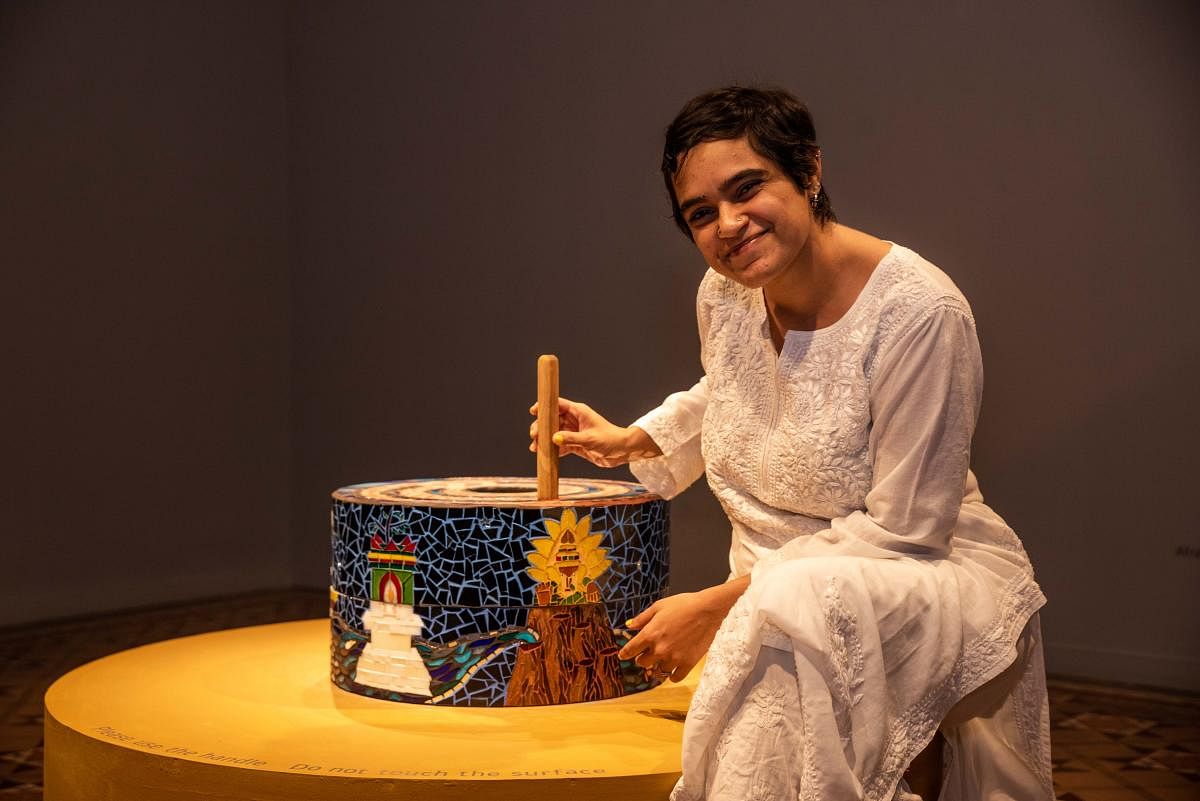
Growing up in a village, which looks like a city, you ask the tree in front of your house to narrate a story. Maybe, deep down, its roots are collecting hidden myths and folklores.” This statement, painted on a scroll by artist Asavari Gurav, at the recently concluded multi-media art exhibition, ‘Retellings’, at Sunaparanta Goa Centre for the Arts, takes us to the magical world of folk tales and how they are a part of our lives.
“Folk tales are absurd, magical, and have their own logic. They are like air; we are surrounded by them all the time,” says Gurav, while explaining her work titled, ‘Once Upon A Time.’
Gurav, along with five other artists, Afrah Shafiq, Bhisaji Gadekar, Komas, Nandita Kumar, and Poonam Pandit, who live and work in Goa, are trying to retell and reinterpret experiences rooted in mythology, folklore, folk art, nature, and the post-truth world through their works. They are the grantees of the Goa Open Arts Catalyst Grant 2020, which was instituted at the onset of the Covid-19 pandemic with the intention of providing ongoing support to the artistic community of Goa. These artists are gazing beyond the obvious sun-n-sand clichés of Goa. They are delving deeper to understand its complexity and, at the same time, celebrate it.
Syncretic nature
Multimedia artist and filmmaker Afrah Shafiq’s installation of a wooden grinding stone titled, ‘A Tale of Two Sisters,’ with audio of songs sung by local women, showcases the syncretic nature of worship across Hindu and Catholic traditions in Goa. She has made a mosaic of the iconic images of Goa — Tulsi Vrindavan, cross, termite hill, snakes, goddesses like Shantadurga and Mother Mary to explain this bond. She is making a comment on the female goddesses of Goa and the role they play in a Goan society where people from both communities worship them. But why a grinding stone? “It was an object young women spent a lot of time with. It was a witness to their stories. It is also about the churning of time,” explains Shafiq.
In his collection, ‘SecondSkin II’, Bhisaji Gadekar has used bamboo fibre to stitch outfits that not only look impressive, but are also a tribute to the traditional bamboo weaving community of Goa. “For this community, bamboo is like a second skin,” says Gadekar.
He mentions that this craft of making bamboo artifacts is almost dying and now there’s a need to give it new dimensions, and most importantly, make the community realise the value this skill has. He adds, “Initially, they had apprehensions, but now looking at the work, they are willing to do more.”
A culture of fibre
The first edition of this project took the form of terracotta installations inspired by Azulejo and its relationship to the history of Goa. Another installation that speaks about fibre is of textile designer and weaver Poonam Pandit’s, ‘Interwoven.’ She uses natural fibres like jute, cane, grass, banana, cotton, wool and synthetic fibres that are bioluminescent, neon, recycled polyester, retro-reflective and fibre optic. “I am following the trail of fibre and thread and how it is used traditionally and culturally from the past to the present,” says Pandit who, under her label ‘Kalakar,’ focuses on conserving Goa’s valuable heritage of handloom weaving. She even worked with designer Wendell Rodricks on the traditional Kunbi saree of Goa.
In her installation, there’s a reference of ‘nave’ or new harvest of paddy, which is offered on the Ganesh Chaturthi festival or the feast which is held after the first harvest. She has also exhibited the traditional ‘Pancha’ or ‘Valo’ made in collaboration with local weavers, a garment generally used as a towel. Along with natural fibres, she has also used polyester derived from recycled PET bottles. Along with Goa’s art and craft, the exhibition is also about the state’s natural heritage.
The sound installation, ‘Mollem Resonance’, by Komas (that consists of Enit, ko, Srinivas) is a 36-minute audio, comprising various sounds collected from the Mollem National Park. “The sound in the forest is quite rich and noisy. We have changed the frequency, created beats using computer-based digital processing software as well as live musical instruments and vocals. This is an attempt to bring out the subtlety of the forest and create harmonies,” explains Srinivas.
He adds that the whole idea behind this project was to feel connected to the forest and not to consider it as something separate. The last installation is by new media artist Nandita Kumar, who is making a strong comment on the post-truth world. Titled, ‘From Paradigm To Paradigm In The Bionic Time,’ it is representational of a newspaper press going in a constant loop... the constant regurgitation of misinformed and manipulative facts by individuals who have the ability to influence public opinion to protect their own interests. “These are the 91 statements that are environmentally incorrect or factually wrong, made by influential people right from politicians to scientists. I have generated them into Haiku and after that, I brailed it. The idea behind this project is for people to read and be more aware,” says Kumar, who is in the process of compiling all this data into a book.